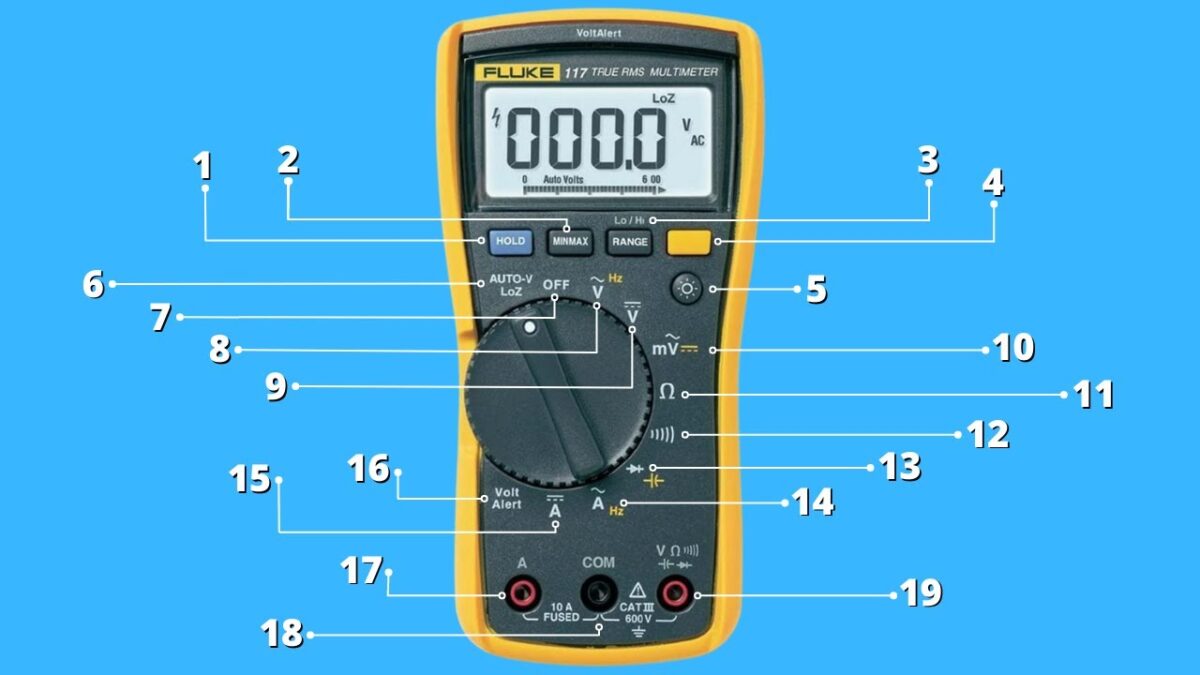Table of Contents
ToggleMultimeter Symbols, Multimeters are essential tools for anyone working with electrical circuits, whether you’re a professional electrician, an electronics hobbyist, or just a curious DIYer. They allow you to measure voltage, current, resistance, and other electrical properties, helping you diagnose problems or test components. However, if you’re new to multimeters, the array of symbols on the device can be intimidating. This article will break down these multimeter symbols, explaining their meanings and uses in a clear, approachable way.
What is a Multimeter and Why Are Its Symbols Important?
The Basics of a Multimeter
A multimeter is a versatile measuring instrument that combines the functions of several tools into one. With a multimeter, you can measure:
- Voltage (V): Both AC (alternating current) and DC (direct current) voltages.
- Current (A): The flow of electric charge in a circuit.
- Resistance (Ω): How much a material opposes the flow of current.
- Continuity: Whether a circuit is complete or has any breaks.
- Additional features: Many modern multimeters also measure temperature, capacitance, frequency, and more.
Understanding how to use a multimeter starts with knowing what the symbols on it mean. These symbols indicate what you’re measuring, the mode you’re using, and sometimes the range of measurements.
The Role of Symbols in Operation
Multimeter symbols are like a universal language for electricians and technicians. They save space on the device and provide quick, intuitive access to various measurement modes. However, because they’re not always self-explanatory, learning their meanings is crucial to using the tool safely and effectively.
For example, mistaking the symbol for voltage with that for current could lead to incorrect readings or even damage to the multimeter. Knowing these symbols not only makes your work more efficient but also ensures you don’t inadvertently cause harm to yourself or your equipment.
Common Multimeter Symbols and Their Meanings
Voltage (V)
Voltage symbols are among the most frequently used on a multimeter. Voltage measures the potential difference between two points in a circuit. The symbols for voltage are:
- V– or DC Voltage: Represented by a “V” with a solid line above a dashed line. This is used to measure direct current voltage, commonly found in batteries and DC-powered circuits.For instance, if you’re checking the voltage of a 9V battery, you’d set the multimeter to this symbol.
- V~ or AC Voltage: Depicted as a “V” with a wavy line above it. This measures alternating current voltage, which is typical for household outlets and AC-powered devices.
Understanding the distinction between AC and DC is vital. If you’re not sure which type of voltage you’re measuring, you could end up with inaccurate results or even damage your multimeter.
Current (A)
The symbols for current measurement are usually marked as:
- A– or DC Current: Indicated by an “A” with a straight line above a dashed line. This measures the flow of direct current.For example, when checking how much current a motor is drawing from a DC power source, this is the setting you’d use.
- A~ or AC Current: An “A” with a wavy line above it. This measures alternating current, often used for larger appliances.
Measuring current often requires the use of different input jacks on the multimeter, so always consult the user manual to ensure proper setup.
Resistance (Ω)
The Greek letter omega (Ω) represents resistance, a measure of how much a component opposes the flow of current. Resistance measurements are crucial for tasks like:
- Checking if a resistor matches its rated value.
- Diagnosing open or short circuits in wires.
- Testing the integrity of components like switches or relays.
When you set your multimeter to the resistance mode, you’re essentially checking whether the material allows electricity to flow easily.
Advanced Multimeter Symbols
Continuity (•∮•)
The continuity symbol often looks like a diode or a soundwave icon. This mode checks whether a circuit is complete. If there’s continuity, the multimeter will usually emit a beep, indicating that electricity can flow uninterrupted.
This feature is incredibly useful for:
- Identifying broken wires.
- Verifying if soldered joints are intact.
- Ensuring switches are working correctly.
Capacitance (F)
Capacitance, measured in farads (F), is represented by a symbol resembling two parallel lines with a curve. This mode measures the ability of a capacitor to store electrical energy.
For example, when repairing an air conditioner or other appliances with capacitors, you’d use this setting to verify their health and capacity.
Frequency (Hz)
Frequency, measured in hertz (Hz), is shown as “Hz” on most multimeters. This setting is used for measuring the number of cycles per second in AC signals, which is crucial for tuning circuits or checking the performance of oscillators.
How to Use Multimeter Symbols Effectively
Reading the Dial
The rotary dial on your multimeter is where most symbols are located. Before taking any measurement, you’ll need to:
- Turn the dial to the appropriate symbol.
- Ensure the test leads are plugged into the correct ports.
- Confirm that the range is appropriate for what you’re measuring (if your multimeter doesn’t auto-range).
For example, if you’re measuring DC voltage, rotate the dial to the “V” symbol with a straight and dashed line.
Safety Precautions
- Double-check symbols: Before connecting your multimeter to a circuit, verify that you’ve selected the correct mode.
- Inspect test leads: Damaged leads can result in inaccurate readings or even electrical shock.
- Avoid overloading: Ensure the range you’ve selected can handle the expected measurement.
Interpreting Results
When you’ve taken a measurement, understanding what the numbers mean is the next step. For example:
- A resistance reading of ∞ or OL (overload) indicates an open circuit.
- A low voltage reading on a DC circuit might point to a drained battery.
Conclusion
Multimeter symbols may seem daunting at first, but they’re the key to unlocking the full potential of this versatile tool. By understanding what each symbol represents and how to use them, you’ll be better equipped to tackle any electrical or electronic project. Whether you’re diagnosing a fault, testing components, or learning about circuits, mastering these symbols is an essential step toward becoming proficient with a multimeter.
So, the next time you pick up a multimeter, take a moment to familiarize yourself with its symbols. You’ll not only work more efficiently but also gain confidence in your skills. Happy testing!














